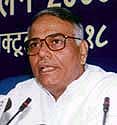|
 New Delhi: This entire hullabaloo started when Standard and Poors (S&P), on 19 September 2002, downgraded Indias long- and short-term local currency ratings. The long-term sovereign local rating was lowered to BB+ from BBB- and the short-term local currency sovereign credit rating to B from A-3. But the company affirmed the BB long-term and B short-term foreign currency sovereign rating for India. New Delhi: This entire hullabaloo started when Standard and Poors (S&P), on 19 September 2002, downgraded Indias long- and short-term local currency ratings. The long-term sovereign local rating was lowered to BB+ from BBB- and the short-term local currency sovereign credit rating to B from A-3. But the company affirmed the BB long-term and B short-term foreign currency sovereign rating for India.
S&P managing director John Chambers said the local currency downgrade reflects the governments growing Indian rupee debt burden and its inability to stem the financial weakening of the public sector. Indias central government, a coalition of two dozen ragtag political parties, has been unable to contain its growing budget deficit, expected to touch 6 per cent of the gross domestic product (GDP) in the current fiscal, Chambers added. As a result the consolidated debt of the central and state governments is estimated to exceed 80 per cent of the GDP this year.  Indian leaders inability to implement the announced reform policies in a timely manner is contributing to Indias falling credit worthiness, Chamber claimed. Citing an example he said political disagreements threaten to set back Indias privatisation programme, which had enjoyed success in recent months. Indian leaders inability to implement the announced reform policies in a timely manner is contributing to Indias falling credit worthiness, Chamber claimed. Citing an example he said political disagreements threaten to set back Indias privatisation programme, which had enjoyed success in recent months.
Despite the downgrade of its local currency rating on the country, S&P stated that its foreign currency rating on eight Indian corporates Indian Oil Corporation, Indian Railway Finance Corporation, Larsen and Toubro, National Thermal Power Corporation, Power Finance Corporation, Tata Engineering, Tata Power and Reliance Industries remained unchanged. Ground realities
Even before 19 Septembers downgrading, Yashwant Sinha, Indias former finance minister, had declared in August 2002: We will carry out the reforms agenda without being hostage to anyone. Sinha had questioned the rationale for the downgrading of Indias sovereign credit rating earlier by S&P and by Moodys Investors Services, saying that the rating agencies were not adding to the countrys wisdom by noting their concern over the rising fiscal deficit. I am aware of the fiscal situation more than anyone else and I have been the biggest advocate of fiscal discipline, he had said. In this context, he had pointed out that the government has initiated several measures, such as the introduction of the Fiscal Responsibility Bill and other legislations, to curb excess government spending. Reserve Bank of India governor Dr Bimal Jalan had also affirmed that there was no domestic debt crisis, saying that there was no domestic debt crisis. The latest S&P downgrading of the local currency rating from investment grade to junk had virtually no effect on the Indian stock markets. Early 20 September morning, bond prices fell, but by about 10.30 in the morning everything was normal. Mind you, it was the last day of the Ganesh festival and in Mumbai, and business on that day is normally sub-normal. The next day too things were normal and no upheavals happened. Says an analyst: No one here cares for S&Ps ratings. The rupee rose by 5 paise to the US dollar. But the local currency market is dominated by domestic investors who cannot invest abroad. The currency market is, therefore, expected to recover soon. How the downgrade will affect foreign investments coming into India is yet to be seen. So far there are no adverse noises from any quarters. Soothing voices
Union finance secretary S Narayan has said the S&P downgrade would affect foreign borrowings. But he said it will not have any impact on foreign investment. Indias trade and industry have reacted sharply to the downgrade and have declared that the downgrade was not justified. In a sharp reaction, Confederation of Indian Industry (CII) president Ashok Soota, along with CIIs national council, said: This is nothing but a knee-jerk reaction of S&P to the temporary deferment in disinvestment of oil sector public sector units. India now has over $62 billion in foreign currency reserves one of the highest among developing economies and adequate to cover over 14 months of imports. Today, due to a competitive exchange rate, India is again showing 20-per cent export growth. The countrys current account deficit is at a historical low of less than 0.5 per cent to the GDP, which can easily increase to over 2 per cent, Soota said. Associated Chambers of Commerce and Industry chief K K Noharia said it was unfortunate that downgrading of the rating had come at a time when the economy had started responding and signs of fresh investments were becoming visible. PHD Chamber of Commerce and Industry president Arun Kapur added: The downgrading has been done without fully comprehending the strength of Indian economy. The rating has no meaning since it has not taken into consideration the fundamentals of the economy, which include a strong agricultural base and an extensive industrial set-up. While the markets have ignored the downgrade, it is good to witness the industry becoming upbeat about the Indian economy despite the downgrade. This is perhaps what the Indian industry needs most of all a change in the mindset and going about ones business irrespective of what international rating agencies have to say.
|